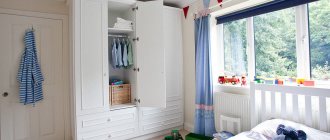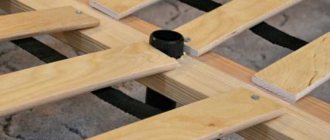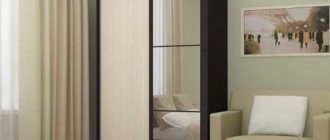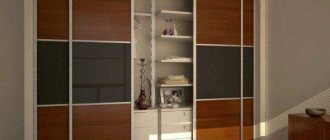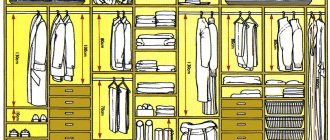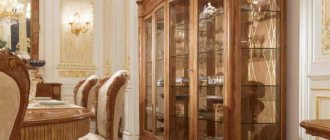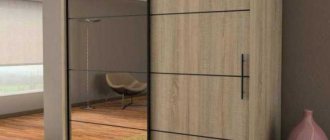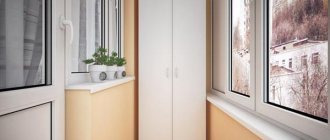When you need to close wall defects or simply update the interior, you may be faced with the problem of choosing a wardrobe. This is a multifunctional design that not only acts as a niche for storing things, but also helps to hide a visually unfavorable corner or part of the wall covered with scratches, cracks, etc. If you don’t know how to choose a sliding wardrobe, the tips and recommendations presented our article will help you with this.
How to choose the right material
Most often, sliding wardrobes are made from finely dispersed fractions and compressed wood shavings. Both types of raw materials are in the middle price segment and are characterized by increased strength. Chipboard and MDF are considered budget materials from which cabinet furniture is assembled. There are cabinets made from solid wood on sale, but more often they are made to order.
Basic materials for making doors
Chipboard
Chipboard is conventionally divided into several varieties. Main differences:
- Strength. For the manufacture of furniture, chipboard of group P2 (category 2) is used, and P1 (category 1) is used as a building material.
- Structure. There are 2 types: fine-textured (M) and ordinary (O) slabs. M is used in the furniture industry and can be laminated.
- Processing method. The cabinets are made from polished (Ш) chipboard sheets. They, in comparison with unpolished ones (NS), are more amenable to lamination.
- Safety. In residential premises it is permissible to install cabinet furniture made from slabs of class E0.5 and E1. They contain an acceptable level of formaldehyde, which can be released into the air.
The raw materials used to make chipboard are completely natural. Sawdust and shavings fall under the press. Resin and temperature exposure allows you to transform the crumbly mass into a dense sheet. Chipboard is amenable to any mechanical processing (trimming, sanding, milling and lamination).
Freestanding cabinet wardrobe. Combined doors with mirror and chipboard inserts. The main decor of the cabinet frame is wenge color
MDF
Medium Density Fiberboard (MDF) for furniture facades is not inferior in quality to chipboard. The material is moisture and heat resistant: when liquid gets on it, it does not swell and can withstand temperatures up to 240 °C. MDF boards are immune to fungal bacteria and mold.
Freestanding and built-in wardrobes. Advantages and disadvantages
It would be incorrect to say that a built-in structure is better or worse than a free-standing one. Each of them is optimal for its placement option and deserves positive reviews.
The main advantages of built-in wardrobes:
- Lower price compared to free-standing ones (due to the absence of a box, material consumption and labor costs for production and installation are lower).
- No gaps (with high-quality installation) between the ceiling, walls and floor. This significantly improves the aesthetics of the appearance and makes cleaning the room easier.
- Possibility of installation in rooms with multi-level suspended ceilings.
- When updating the interior, the appearance of the wardrobe can easily be changed by replacing the doors. The fastening system is not affected.
When ordering a built-in wardrobe, you need to remember that its quality and appearance largely depend on correctly taken measurements and the qualifications of the specialists performing the assembly.
In this regard, we advise you to find a good company that will send an experienced craftsman to you. All measurements and calculations of the future design, as a rule, are performed free of charge. A good help for preliminary calculation of a built-in wardrobe is the online calculator program. It can be found on the websites of large manufacturing companies. For example, by going to the website of the Alait wardrobe factory, you can easily calculate your built-in wardrobe.
Among the disadvantages of built-in structures, we can note the fact that they are all made for a specific room. Therefore, if you move, the likelihood of optimal adaptation to the new room is very small.
Cabinet sliding wardrobes have the following advantages:
- Easier and faster installation. All structural parts are already adjusted to size and equipped with the necessary holes. Assembly proceeds without dust or debris.
- The appearance of the facade does not depend on the evenness of the walls of the room, its floor and ceiling.
- The possibility of dismantling the structure when changing place of residence and independence from the dimensions of the new premises.
- Possibility of rearrangement within the apartment when updating the interior.
Disadvantages of case systems:
- Irregularities in the walls of the room do not detract from the appearance of the cabinet, but become noticeable when it is located close to them.
- Compared to a built-in wardrobe, the box reduces the internal usable volume.
Dimensions
Cabinet parameters are selected individually. In terms of height, furniture can be:
- large (up to 2.65 m);
- standard (up to 2.5 m);
- small (up to 2 m).
Standard wardrobe dimensions:
- height - 2–2.65 m;
- distance between shelves - 15–20 cm;
- base (height) - 8–10 cm;
- width - 2.5–3 m;
- shelf width - 65–80 cm;
- rod length - up to 1 m.
The optimal depth is about 60 cm. Retractable rods will provide you with additional space convenient for storing clothes. The door width of the classic model is 140–145 cm.
Standards and recommended door sizes for sliding wardrobes
Choosing a wardrobe by type of room
Furniture stores have a large selection of interior items of different sizes and shapes. The selection of a wardrobe is carried out not only taking into account the size of the room, but also based on its purpose. A piece of furniture suitable for a bedroom will most likely be out of place in a children's room or hallway.
Choosing a wardrobe by type of room
Wardrobe in the living room
This is usually the largest room in a house or apartment where the whole family gathers. How to choose a wardrobe for the living room? Many different things are most often stored here: books, clothes, personal items and much more. For a room in which family members spend most of their time and receive guests, you will need a wardrobe with the following parameters:
- large capacity;
- the presence of open sections for placing souvenirs and accessories;
- Closable niche for TV or computer.
Installing a wardrobe in the living room allows you to divide a large room into several functional areas. This piece of furniture can be built into a niche and occupy the entire space of one of the walls from floor to ceiling. This will prevent dust from accumulating in the corners.
Sliding wardrobe for the living room
Wardrobe in the bedroom
Rooms intended for sleeping usually have a small area and furniture for them must be selected especially carefully. How to choose a wardrobe for the bedroom, so as to avoid clutter? The best option would be to build it into a niche, which will reduce the cost of purchasing it. After all, for its body you can use materials without expensive exterior finishing. In the bedroom, a wardrobe usually serves as a dressing room and is designed to store clothes, bedding and other items. Accordingly, it needs to provide compartments for linen and other things. A large mirror in the sliding door will allow the hostess to admire herself in full height and visually increase the size of the room.
Wardrobe for bedroom
Wardrobe for children's room
Furniture for the room in which a child lives must, first of all, be safe and withstand significant loads. How to choose a wardrobe for a nursery? The materials used for its manufacture must be environmentally friendly. MDF has the best price-quality ratio; chipboard with low phenol-formaldehyde resin emissions is acceptable. Interior items in the nursery should not have sharp corners or protruding elements. Instead of handles on pull-out drawers, you can use slots. Glass and mirror facades are unacceptable; a child may inadvertently break them and be injured by the fragments. To decorate the facade, black magnetic film can be used, on which you can draw with chalk or attach letters, pictures and applique elements to it.
Sliding wardrobe for a children's room
Sliding wardrobe for office
The workspaces are equipped with functional and beautiful furniture. The question arises, how to choose a wardrobe for an office, which most often is also a library. You will need fairly strong shelves of small depth to accommodate books. They can be closed with solid or glass doors. The former reliably protect the paper from fading, the latter prevent the accumulation of dust. For collectors, sliding wardrobes are most often made to order, and the height and width of the shelves in them are selected based on the size of the items being collected. The doors must have secure locks. For those who are used to working from home, they need places to store documents and information materials. Office folders with labels will look good in open niches.
Sliding wardrobe for office
Sliding wardrobe for the hallway
When entering an apartment or house, we take off our outerwear and shoes. Accordingly, the wardrobe in the hallway should have at least three compartments: two for the items mentioned above and one more for gloves, umbrellas, hats and many other things. It is advisable to make the doors for sliding wardrobes mirrored - this will allow you to inspect yourself before leaving the house. When solving the problem of how to choose a wardrobe for a hallway, its size and configuration are taken into account. If there is a niche, it is better to build furniture into it, thereby freeing up some of the space. If the layout of the room allows, it makes sense to install corner furniture, then the space will be used as efficiently as possible.
Sliding wardrobe for the hallway
Which doors are better
Only sliding doors are installed on cabinet and built-in wardrobes; the presence of side-sliding doors allows you to save space. They are divided by type of material:
- made of plastic;
- made of natural wood;
- glass, mirror.
Doors for cabinets made of plastic are lightweight and slide apart without much effort. They do not allow sunlight and foreign odors to pass through. Solid wood models are considered the most environmentally friendly and durable - a closet with such doors can even be installed in a child’s room.
Expert opinion
Victoria Chernikova
Decorator
A completely mirrored surface of the door will visually enlarge the room. When decorating with glass and mirrors, one must not forget about basic safety measures - they must be covered with a protective film, which will protect against abrasions and cuts in the event of a strong impact.
Profile selection
Door opening systems are divided into 4 main categories:
- Frame. The profile is made of aluminum or steel and has a groove-like shape. There are dividers on the doors.
- Frameless. Budget option without a profile. The wheels are attached to the door panel, so the service life is short.
- Roller. The suspension is fixed on the door. The roller glides along the “rails” silently.
- Radial. Profile of non-standard shape with a semicircular bend. Requires individual development depending on the model.
Basic criteria for choosing a wardrobe
When planning the purchase of furniture, we proceed from functional needs and our own stylistic ideas. In order not to make a mistake when choosing a wardrobe, you must follow simple rules:
- You should purchase exclusively products from leading manufacturers who value their reputation and control the quality of their products.
- Particular attention must be paid to the choice of material. Almost all modern furniture is made from particle boards and MDF, the former can be veneered or finished with polymer films.
- It is necessary to ensure the quality of metal elements and other fittings, as well as the strength of the fastenings. The functionality of the described piece of furniture directly depends on the capabilities of the door opening system.
- It is worth considering the type of room.
- Determine the dimensions of the wardrobe that will harmoniously complement the parameters of the space.
- It is also necessary to decide on the style of decorating the facades.
Wardrobe in the interior
Internal structure
Depending on the future placement of the wardrobe and personal needs, you need to determine the components of the “filling”. The filling of the wardrobe is selected based on the internal structure of the shelves. It includes:
- rods;
- hangers;
- drawers (lower and upper);
- shelves.
It is preferable to store bulky items on the mezzanine, clothes and bed linen on the middle shelves. Drawers are in most cases located at the bottom; they are convenient for storing shoes and small accessories.
Expert opinion
Tatiana Leontyeva
Professional housewife
Rods with hangers for jackets and fur coats should be placed at an accessible height to easily remove clothes. You can install them yourself to the required size. Compartments for shirts and T-shirts should be separate from hangers for fur coats.
Wheels of the running system
The movement of doors in sliding wardrobes along the guides is ensured through the use of rollers. Wheels in sliding systems for sliding wardrobes are made from different materials: the most affordable ones are made of plastic, the more expensive ones have a steel base and are equipped with a ball bearing. To reduce noise levels and reduce vibration, a rubber or polymer tire is placed on the metal rim. The running roller is fixed on an axis, which is installed in a special bracket. This design is mounted on the door using self-tapping screws. The wheel rolls along the sliding wardrobe guide in both directions; limiters are installed at the end points to prevent them from jumping out and hitting the body.
Wheels of the running system of sliding wardrobes
For the hallway
A sliding wardrobe in the hallway will allow you to store shoes, casual and seasonal clothes, as well as various small items in one place. The corner model will accommodate shoe care products, umbrellas, bags, accessories (sunglasses, scarves). To visually expand the room, doors can be decorated with mirror panels.
For the living room
Before purchasing a wardrobe for your living room, be sure to measure the height to the ceiling. If it is tensioned indoors, then the distance between it and the cabinet should be 10–15 cm. Modern trends in furniture fashion suggest installing models with partially open shelves and a niche for the TV area. Bed linen, towels and pajamas for guests can be stored behind the doors.
The history of the wardrobe
The history of the creation of the sliding wardrobe
Today it is almost impossible to reconstruct the history of the first sliding wardrobe. There are several versions of the origin of the wardrobe.
Some historians believe that sliding wardrobes were made back in the sixteenth century by Italian craftsmen. Italian craftsmen made wardrobes with sliding doors for people living in small rental homes, and sliding doors were very suitable for saving space. Some believe that the Japanese were the founders of sliding wardrobes. Sliding doors were often used in Japanese homes, both as an entrance door and for interior doors and closets.
But according to the main version, the founder of the wardrobe is Napoleon Bonaparte. The great commander really did not like the bachelor's disorder in the apartments of reckless officers. So he ordered: uniforms and other props should be kept in one place - behind a screen on racks. This is how a simplified storage closet in a traveling version appeared. The wardrobe was brought to life by practical Americans. They replaced the screen with a door, attached plastic wheels to it and launched it along the narrow-gauge railway. Now the door opened not traditionally “towards you”, but to the side. And it was a real revolution in the interior! This happened in California in the mid-twentieth century. The next decades were spent refining the cabinet: the doors began to be made completely mirrored, and to prevent them from breaking, they were reinforced with a special protective film (akin to a triplex car), the roller mechanism was improved (at first the wheels “made noise” and slipped off the rails). And now a modernized wardrobe has become as indispensable an attribute of an American home as, say, a traditional fireplace for conservative Englishmen.
In our country, the first sliding wardrobes appeared in 1995-1996. The first companies that offered sliding wardrobes targeted consumers with high incomes. All sliding wardrobes had the same mirrored doors, but panel doors were offered in two options: made of chipboard and veneered with natural wood. The introduction to the market began with the Stanley steel profile and the aluminum profile offered by the Neves company.
Since the mid-90s, sliding wardrobes began a new, “Russian” stage of development. Feeling the prospects, our craftsmen turned built-in structures into full-fledged furniture. Side walls and a roof were added to the sliding mechanism, plus a little imagination from the client. The result is something universal: for clothes, books, dishes, household appliances. Right down to folding beds and desks. Obviously, at this moment the “purely Russian” name appeared - wardrobe. It is not surprising that such products unexpectedly became something completely special and previously unseen.
The simplest wardrobe consists of two or three doors, a box built into a wall niche, and a sliding mechanism. It was precisely these sliding wardrobes that were brought to the Russian market in the early 90s and were revered for some time as the latest in high fashion.
A wardrobe door is something (mirror, panel or glass) bordered by a horizontal and/or vertical profile (the concept of frame is also used on the market), that is, something covered in a frame. The door rides on upper and/or lower tracks (there is a concept on the market called upper and lower tracks). To prevent the doors from hitting the side panel or wall, either a brush or transparent round pads are glued to the vertical profile, which serve as a damper.
The system is everything that is needed to assemble a wardrobe, excluding mirrors, panels and glass, that is, it is “hardware” made of steel or aluminum. The system includes a profile, guides and wheels. Systems can be either sliding or folding into a book (in the market they are called sash systems). Oddly enough, now the concept of a wardrobe includes ordinary doors on hinges (in the market they are called hinged), although in a wardrobe these doors are equipped with a frame. A modern wardrobe successfully combines sliding, door and hinged systems. But it all started with sliding systems.
So, about the steel system: At first, doors for sliding wardrobes were imported from England and therefore were available only to wealthy people.
In 1997, components began to be brought to Russia and ready-made wardrobe doors were assembled. This made it possible to reduce costs, and in the meantime, a class of consumers with an average level of income was formed, who, having saved money, could afford to buy a wardrobe. The final price of the cabinet was very attractive to the new owners, and they showed up.
Since 1997, some Russian companies began selling the same Stanley steel profile under their own brand. Since 1998, there has been a period of rapid growth in demand for sliding wardrobes. And here the pioneers of the Moscow market for steel systems for wardrobes made a mistake. They advertised that assembling doors was so easy and that for this “action” you only needed to have a table for assembling a wardrobe door. This dealt a blow to quality and hit the consumer hard, since not all intermediary companies (dealers) were able to produce high-quality door assembly. Now almost every store has a sliding wardrobe “ala Stanley”, and the Stanley brand may only own the system; the remaining attributes of the sliding wardrobe (chipboard panels, mirrors and glass) can be either imported or domestically produced.
With aluminum systems, the story that happened with steel is repeated. Four to five years ago, companies that sold French aluminum (Neves) and Polish aluminum (Versal) were monopolists and sold only ready-made wardrobes. The price of wardrobes was high. These companies guaranteed excellent quality. Then German aluminum appeared on the market in the form of the Raumplus brand. Now many companies sell both components and finished products of the Raumplus brand.
Modern wardrobes successfully combine sliding, door and hinged systems.
For children's
A mini-wardrobe with a height of no more than 1.5 m is suitable for a child - this way he can get clothes without standing on a chair. It is best to choose bright colors: pink, blue, purple or yellow. If the doors have glass or mirror inserts, they must be covered with high-quality protective film.
Interesting wardrobe ideas for children's rooms.
